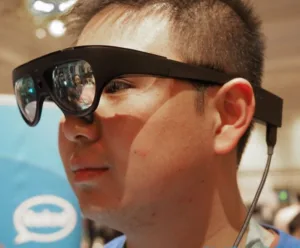An early prototype of the Rokid Glass AR glasses was shown at CES 2018. Glass was designed by Rokid Corporation Ltd., headquartered in Hangzhou, China and with offices in San Francisco, CA.

Perhaps the most interesting aspect of Glass is that it integrates what is currently considered all of the must have features in an AR headset and does so in a physical form that is starting to look – at least a little – like an actual pair of glasses.
Rokid’s projection technology uses a prism positioned above the right eye lens to direct imagery to the upper right corner of the right eye’s field of view. The image appears superimposed over a view of the real world. The image is generated by an OLED display having a resolution of 1920 x 1080. The field of view is currently narrow at 35º. The image is reported as “clear enough to read the bold, basic text on them, but they are far from high-def.” Glass runs a version of Android 6.0. Using a front-facing camera built into Glass, the Rokid AR glasses can recognize and respond to simple hand gestures such as “sliding tiles of a menu left and right by swiping the air or selecting a title by making a fist.”
Integrating all of the components needed into the Rokid Glass along with the requirements of the projection technology resulted in the AR glasses being considerably oversized as compared to conventional eyeglasses. As can be seen in the illustration below, Glass protrudes noticeably from the users face and is supported by a nose pad. In addition, there are oversized arms that stretch back over the user’s ears.
The prototype Rokid Glass AR glasses on show at CES.
Bottom line here is that these prototype AR glasses are a long way from being “discreet”. It will be obvious to even the most casual passerby that the user is not wearing eyeglasses but a head-mounted display. Commenting on the physical size of the Glass, Rokid stated that the CES prototype is larger than the model that will be available to the public later this year. The company says it plans to shrink the size of Glass as well lower its overall weight by incorporating “smaller but equally capable components.”
A video at the end of this article includes a short discussion and demonstration of the Rokid Glass.
Rokid was showing two versions of Glass at CES. One version uses a wireless remote control for navigation. The other version has a motion tracking sensor mounted on top of Glass. The company stated that it intends to eventually shrink the motion tracking sensor module.
Glass was demonstrated by the use of several apps that the company built in-house specifically to show off some of the potential of the system. The more interesting of these apps used the front facing camera for facial recognition. When the app is in use, a crosshair appears in the user’s field of view. When the crosshair is centered on someone’s face, their name, title and a photo of the person will appear in the field of view.
Rokid says it plans to partner with other companies to develop more content for its platform.
The company is working on incorporating a voice interface into Glass so as to enable the user to speak to a built-in digital assistant. At this time, it is not clear if Rokid plans integrate an existing assistant such as Amazon’s Alexa or Google’s Assistant, or if it will develop its own proprietary assistant.
In releasing Glass when it still very much in prototype form, Rokid hopes to “open-source development of apps and collect data on how people actually use the AR functionality.” Based on the information and feedback from this process, it is the company’s intention to improve the design of future models of Glass. -Arthur Berman

